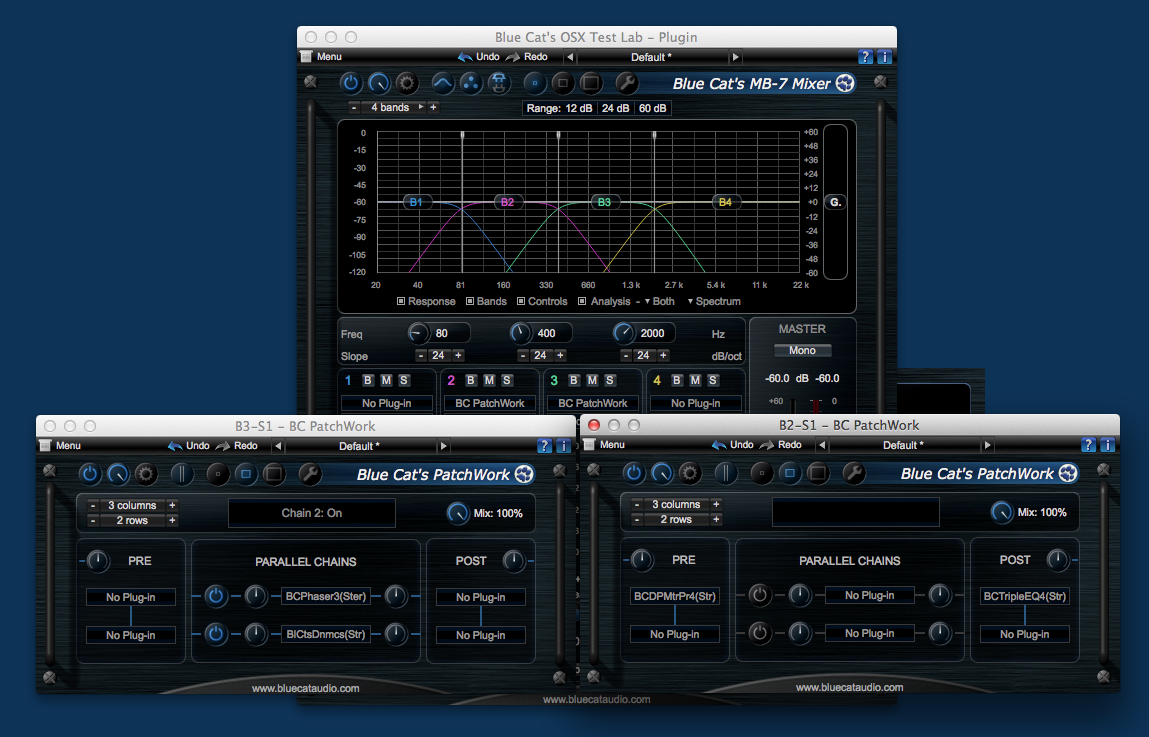 With the release of Blue Cat’s PatchWork, we have been asked many times the differences between this new plug-in and the recently released Blue Cat’s MB-7 Mixer, our multi-band processor that is also able to host VST plug-ins.
With the release of Blue Cat’s PatchWork, we have been asked many times the differences between this new plug-in and the recently released Blue Cat’s MB-7 Mixer, our multi-band processor that is also able to host VST plug-ins.
 Since both plug-ins are very different despite a few common features (mainly regarding VST hosting capabilities), it seems that a short summary is necessary, so here it is!
Since both plug-ins are very different despite a few common features (mainly regarding VST hosting capabilities), it seems that a short summary is necessary, so here it is!
The comparison here focuses on the VST hosting aspect of the plug-ins, since that’s what they mainly have in common.
The Big Picture
Blue Cat’s MB-7 Mixer is a spectral re-mixer plug-in which is able to host VST plug-ins, whereas Blue Cat’s PatchWork is an plug-ins patchbay (or chainer), dedicated to plug-ins and instruments hosting, and plug-ins chains building.
So VST plug-ins hosting is a bonus in Blue Cat’s MB-7 Mixer, and lets you apply effect to several frequency bands, whereas Blue Cat’s PatchWork is built around plug-ins hosting, and does not include any spectral processing of any kind.
In Details
- The MB-7 Mixer can also be used to chain plug-ins (in broadband mode, or with this single band skin), but its memory footprint is larger (the PatchWork plug-in has been really optimized to only host plug-ins and do nothing else, which is not the case of the MB-7 Mixer plug-in).
- Blue Cat’s PatchWork offers parallel plug-ins chains, and up to 64 VSTs in one instance (vs 4 VSTs and no parallel chain for Blue Cat’s MB-7 Mixer used in broadband mode). It just has different routing capabilities.
- Blue Cat’s MB-7 Mixer lets you apply VST effects to different frequency bands, letting the rest of the spectrum unchanged, whereas Blue Cat’s PatchWork applies effects to the entire spectrum (no spectral splitting).
- Blue Cat’s Patchwork has an instrument version that lets you use virtual instruments seamlessly within most hosts application (Pro Tools or Logic for example), whereas the MB-7 Mixer plug-in requires additional workarounds to support VST instruments (for example routing an extra MIDi track into it in Pro Tools).
- Blue Cat’s PatchWork supports multichannel audio tracks (up to 8 channels), whereas the MB-7 Mixer is mono or stereo only.
- Blue Cat’s PatchWork has a global dry/wet (“mix”) control.
- Blue Cat’s MB-7 Mixer has specific stereo functions such as mid/side, spread control, panning etc. that Blue Cat’s PatchWork does not have.
- Blue Cat’s MB-7 Mixer has multiple instances linking capabilities for its controls.
- Blue Cat’s MB-7 Mixer includes a premium spectrum analyzer.
- Blue Cat’s PatchWork is cheaper.
- Basic VST hosting features are the same for both plug-ins otherwise (bypass, presets management, undo/redo integration etc.)
How To Choose?
If you need to process frequency bands separately and alter the spectrum of the signal, go for Blue Cats’ MB-7 Mixer. If on the other hand, you need a plug-ins chainer that lets you do parallel processing and reuse your effects chains between projects, or stack virtual instruments on a single track, go for Blue Cat’s PatchWork!
Hope this clarifies a bit. If you want to know more, check out the demos!




One thought on “Blue Cat’s PatchWork vs Blue Cat’s MB-7 Mixer”